Saag paneer (and palak paneer) are vegetarian Indian dish made of curried greens and fried paneer cheese. You’ve likely come across the dish at your favorite Indian restaurant, but now’s the time to try making authentic saag paneer at home!

What is saag paneer?
Saag paneer is a popular Indian vegetarian dish made of spinach and other leafy greens (called saag) and paneer (Indian cottage cheese).
The greens are ground into a paste, and seasoned with spices. Fried paneer is then added on top.
The origin of this dish is from the province of Punjab in northern India.
What is saag?
In India, the term saag is a generic term that means ‘greens’. The common misconception is that saag means spinach, but the term is quite broad.
In India, saag can include spinach (palak), mustard leaves (sarsoon), chenopodium (bathua), purslane (kulfa), and fenugreek leaves (methi). It can also include beet greens and tender radish leaves.
One of the most famous recipes associated with saag in the Indian sub-continent is sarsoon ka saag. It is a vegetarian dish made of a mixture of leafy greens, and a winter specialty. It is served with makai ki roti (a flatbread made of maize flour) and a dollop of butter or ghee.
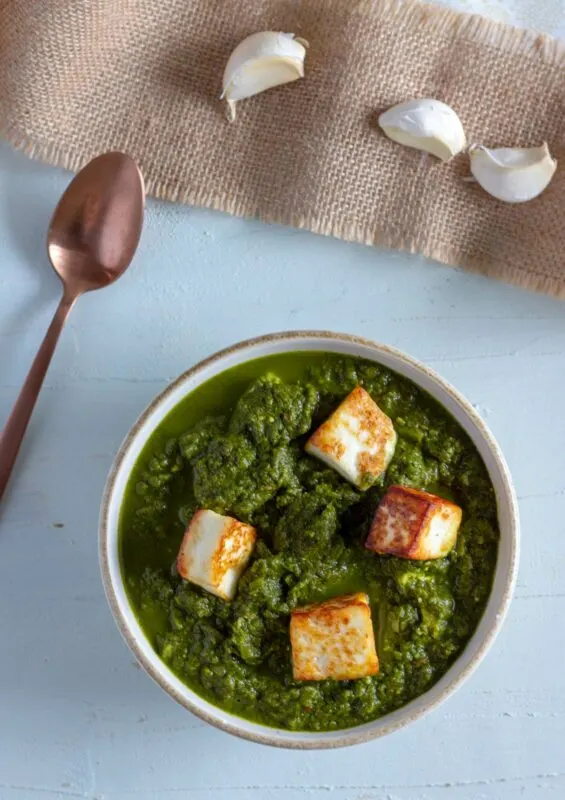
What is paneer?
Paneer or Indian cottage cheese is a fresh cheese made from cow or buffalo milk. The texture is on the firm side, and it doesn’t melt on heating.
It is very popular in India, and is eaten as a snack, as well as a main milk.
It is made by curdling fresh milk with a type of food acid such as yoghurt, lemon juice or vinegar. Once the milk separates and curds are formed, they are separated via a cheesecloth or muslin cloth. Excess water is drained, and the cheese is pressed for 2 – 3 hours to form its shape. (Here is an easy paneer recipe.)
The paneer can then be sliced or cubed, and used in dishes. It can be used as is, or it can be fried or grilled.
In this saag paneer recipe, the paneer is cubed and then shallow fried, after which it is added to the saag mixture.
What can I substitute for paneer cheese?
If you have the time to plan ahead, paneer is one of the easiest cheese recipes to make at home. (See the recipe linked above.)
However, if you can not be bothered to make it yourself or do not have access to it ready-made, Greek Halloumi or Feta work as substitutes. (You need a firm cheese that won’t melt.)
Extra firm tofu could also work in a pinch, but it wouldn’t give the same creaminess to the dish.
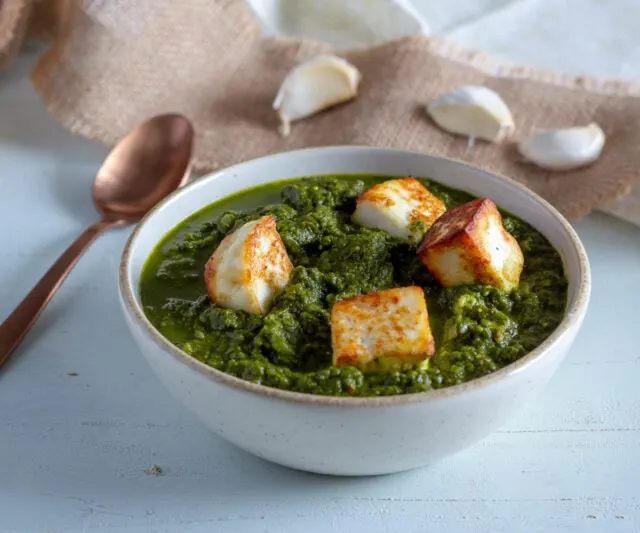
How is saag paneer different from palak paneer?
There is a lot of confusion about the difference between saag paneer and palak paneer.
The traditional Indian dish is palak paneer which is made with palak (spinach) and paneer (Indian cottage cheese).
Saag paneer is a similar vegetarian recipe that is made with a mixture of leafy greens with paneer.
The dish saag paneer is more popular in Indian restaurants around the world, and not as common in India.
In the west, the terms palak paneer and saag paneer are used interchangeably, particularly so in western Indian restaurants.
Ideally saag paneer should have a mix of greens – spinach, mustard greens and/or fenugreek. However, the difficulty of finding Indian leafy greens abroad means that saag paneer is often made with just spinach (palak).
Even in the recipe I shared below, I was only able to find two types of leafy greens – one spinach, and the other fenugreek leaves (methi).
What type of greens can be used in saag paneer?
Ideally, saag paneer should be made from a mix of leafy greens, the bulk of which would be spinach. A ratio of 2 parts spinach to 1 part other leafy greens is best.
Other leafy greens that can be used in saag paneer are mustard greens (sarsoon), chenopodium (bathua), purslane (kulfa), and fenugreek leaves (methi).
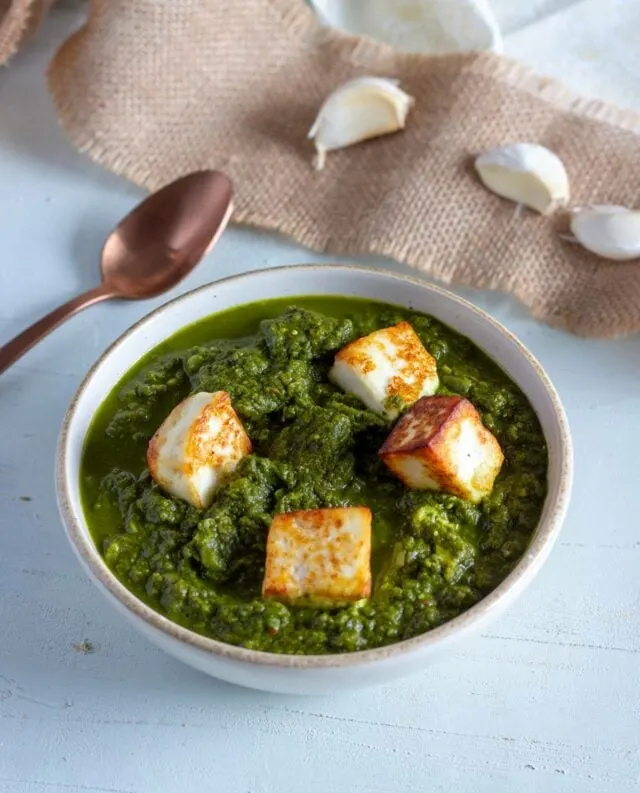
What type of spinach should be used in saag paneer?
Spinach is the easiest green to find and also forms the bulk of the saag paneer gravy. Here’s a breakdown of different types of spinach you may consider using for your saag paneer (or palak paneer, for that matter).
Fresh spinach – ideally fresh spinach leaves of the mature kind. These are available at Indian grocery stores, farmers markets and large supermarkets.
Baby spinach can be used, but the flavor is on the mild side. However, someone who finds regular spinach too bitter may prefer baby spinach.
Frozen spinach – since you turn the spinach into a paste for this particular recipe, frozen spinach is actually a good alternate to fresh spinach, especially when fresh is not in season.
Frozen spinach doesn’t require blanching, but it might require a whiz in the blender to create the saag paneer base.
Canned saag – tinned or canned saag is a common sight in Indian grocery stores. It is sold as ‘saag’ or ‘sarsoon ka saag’ and is available in paste form in a can.
The reason it is so popular is because it’s super convenient (grinding spinach and mustard greens is messy) and because it tastes authentic. It has a mixture of those leafy greens which are so hard to find fresh abroad.
The canned saag can be used in place of the ground spinach paste – just fry it in ghee / oil and give a fresh tempering of spices to add flavor.
Now it’s your turn! Do you order saag paneer at your favorite restaurant? Have you made it yourself? What do you add to make it special? Let us know in the comments below!
Authentic Saag Paneer
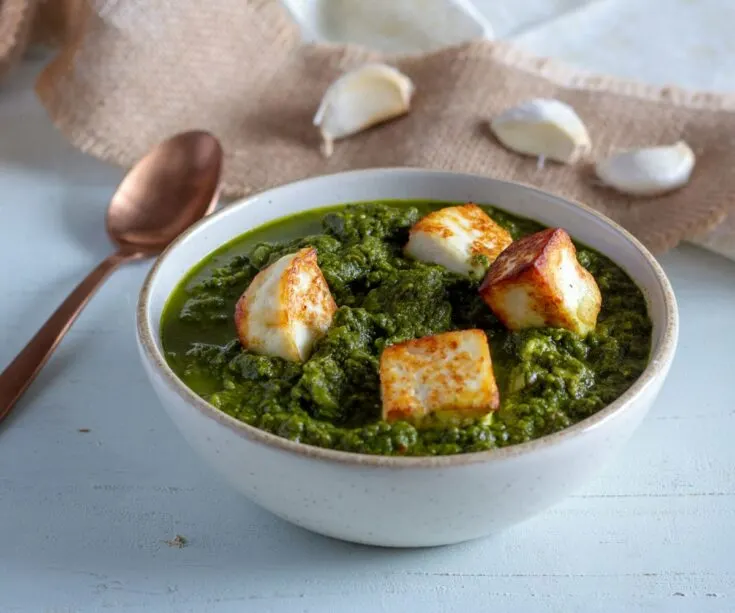
Ingredients
- 21 oz (600 grams) fresh spinach (3 bunches)*
- 7 oz (200 grams) fenugreek leaves (known as methi)**
- 4 Tbsp ghee / clarified butter (oil or regular butter can also be used)
- 10 oz (300 grams) paneer (Indian cottage cheese)
- 1 1/2 tsp cumin seeds
- 6 garlic cloves, finely sliced
- 1 tsp fresh ginger, finely sliced
- 2 green chilies, chopped into 3 pieces
- 2 small onions, finely chopped
- ¾ tsp red chili flakes
- ½ tsp turmeric powder
- 1 – 1 1/2 teaspoon salt
- ½ Tbsp lemon juice
- 4 Tbsp cream (optional)
Instructions
Blanch the greens
- Wash the spinach and fenugreek leaves thoroughly in running water. Drain.
- Break or cut off the spinach stems and then roughly chop the leaves. Set them aside. Do the same with the fenugreek.
- Put a large pot of salted water to boil. Once the water comes to a boil, add the spinach leaves, and cook for two minutes. Remove the spinach from the boiling water and immediately place it in a bowl of ice-cold water with ice cubes in it. (Alternately, place the spinach in a colander and run it under cold running water for a few minutes.) Do the same with the fenugreek leaves. This step is known as blanching and will ensure that the colors of the greens is maintained.
- Drain and lightly squeeze out the excess water from the spinach and the fenugreek leaves. Place the spinach and fenugreek leaves in a blender along with a few tablespoons of water. Grind into a smooth paste. (The recipe up to this step can be done ahead, and the paste can be kept in the refrigerator for 2 days.)
Prepare the paneer / Indian cottage cheese
- Cut the paneer (Indian cottage cheese) into cubes, about one inch by half inch pieces. (For added crunch, dust the paneer with corn flour before frying.)
- Heat 2 tablespoons oil in a medium sized frying pan over medium heat. Once the oil is hot, add the cheese. Fry for about 45 seconds on each side, until the paneer is golden brown.
- Remove the fried paneer from the oil and place on a paper towel. Set aside.
Prepare the saag paneer gravy
- Heat 2 tablespoons of oil in a large skillet over medium-high heat. Add the cumin seeds, and fry for a minute until the cumin seeds start to splutter and release their aroma.
- Add the sliced garlic and ginger and sauté till the garlic turns light golden and releases its aroma.
- Add the green chilies followed by the chopped onions. Fry for 3 – 4 minutes until the onions are light golden. (Reduce the heat as needed as the skillet gets hot.)
- Add the red chili flakes, turmeric and salt.
- Fry the spices for a minute, and then add the spinach and fenugreek puree. Turn the heat to medium-low, as the puree has a habit of spluttering and that can get quite messy. Cook for a couple of minutes until the mixture comes to a light boil.
- Turn heat to low, and add lemon juice, along with about 75% of the fried paneer. Stir through. Add cream (if using) at this stage.
- Remove the saag paneer into a serving bowl. Garnish with the remaining paneer.
- Serve hot with naan or roti.
Notes
*Substitutions for fresh spinach leaves: Ideally fresh and mature spinach leaves should be used. Baby spinach can be used but it will give a milder flavor to the dish and may need an adjustment in salt and spices. In case fresh spinach isn’t available, frozen spinach can be used. Frozen spinach doesn’t require blanching, but it might require a longer whiz in the blender to create a smooth saag paneer base. Another substitution option is canned saag available at Indian grocery stores. A combination of greens, this can be used in place of the ground spinach and fenugreek paste in this recipe. Some brands of saag may already have salt and spice in it, so adjust seasonings accordingly.
**Substitutions for fenugreek leaves: If fenugreek leaves aren’t available it is possible to use only spinach for the saag paneer recipe.
Recommended Products
As an Amazon Associate and member of other affiliate programs, We earn from qualifying purchases.
Nutrition Information:
Yield:
6Serving Size:
1/6 of recipeAmount Per Serving: Calories: 160
If you liked this recipe, here are some similar dishes you may enjoy!

Kiran is originally from Pakistan, and is a food blogger and recipe developer. One of the things that she loves doing is learning about different cuisines and learning how food has shaped culture and history around the world. You can find Kiran on her blog MirchiTales.com as well as on Instagram.



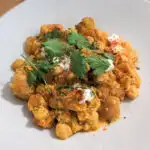





Gerri
Saturday 22nd of October 2022
Can't wait to make! Is there another name for green chilies? Lots of green chilies in my market. Thanks.
Sarah - Curious Cuisiniere
Tuesday 25th of October 2022
Hi Gerri. These would be smaller green chilies. Choose ones that fit your heat preference. Enjoy!
om kumar
Tuesday 19th of April 2022
Lovely recipe Kiran Afzal! I have tried many many of your recipes and they all turn out lovely! My kids used to love only restaurant North Indian dishes. Being a South Indian, I could never capture that. But with your recipes, my kids are enjoying home food 😊 Thank you!! Om Kumar